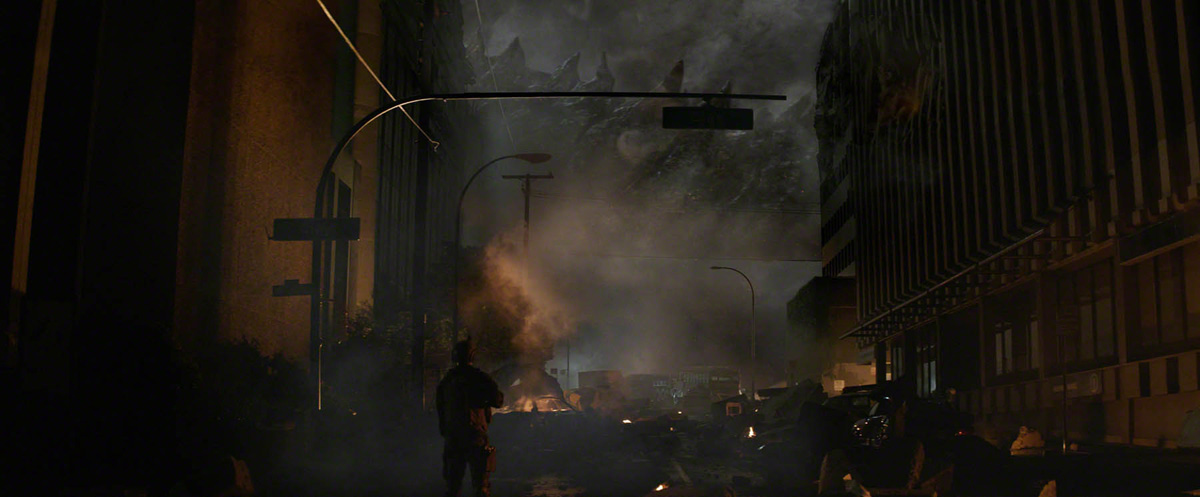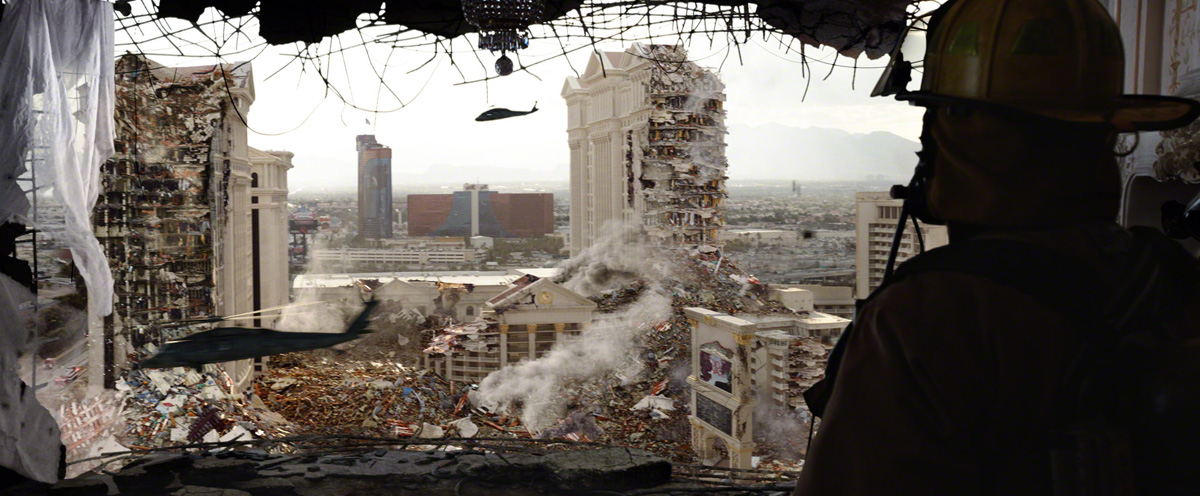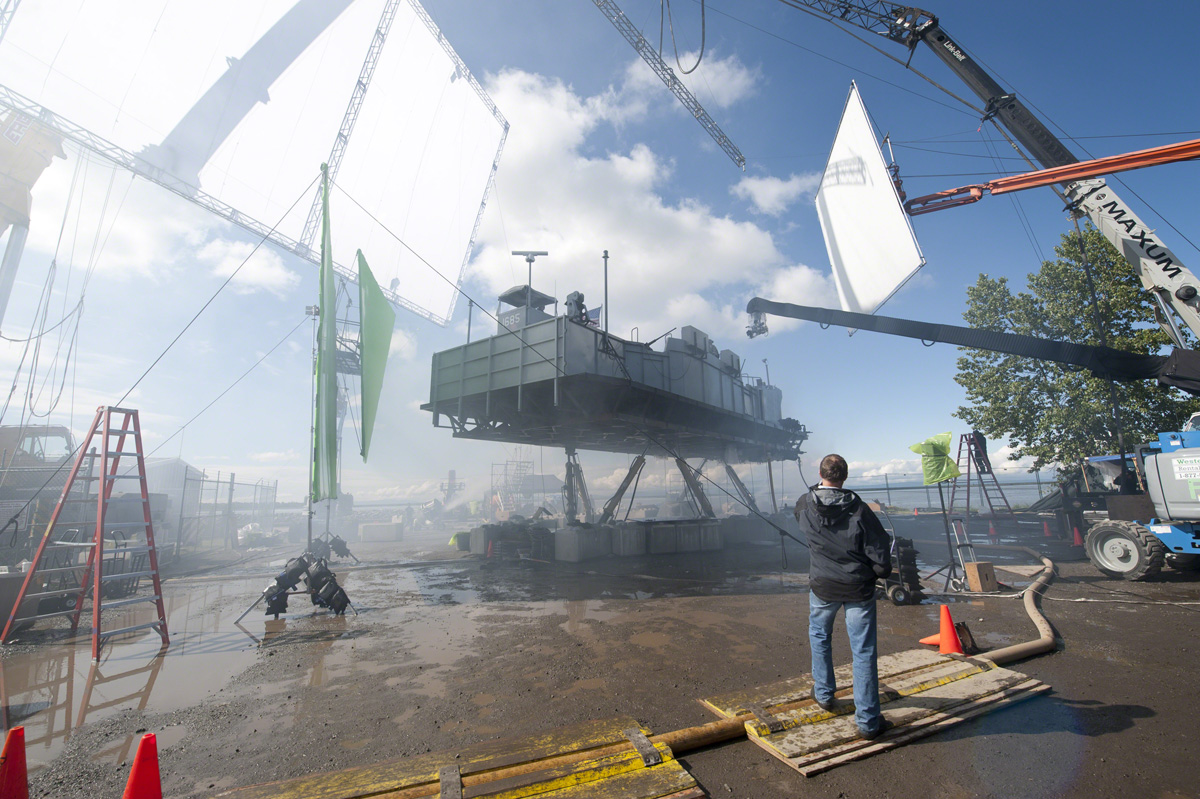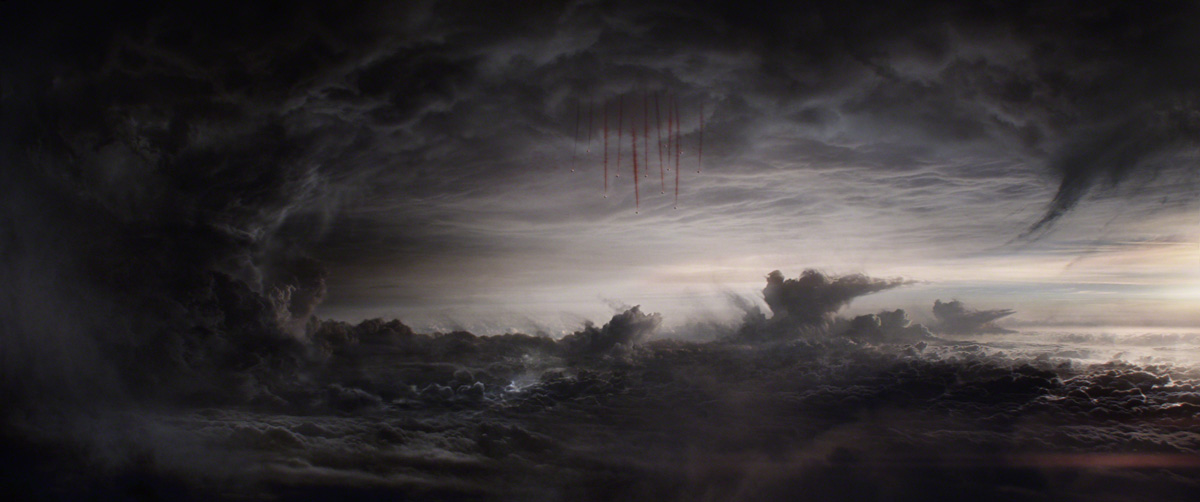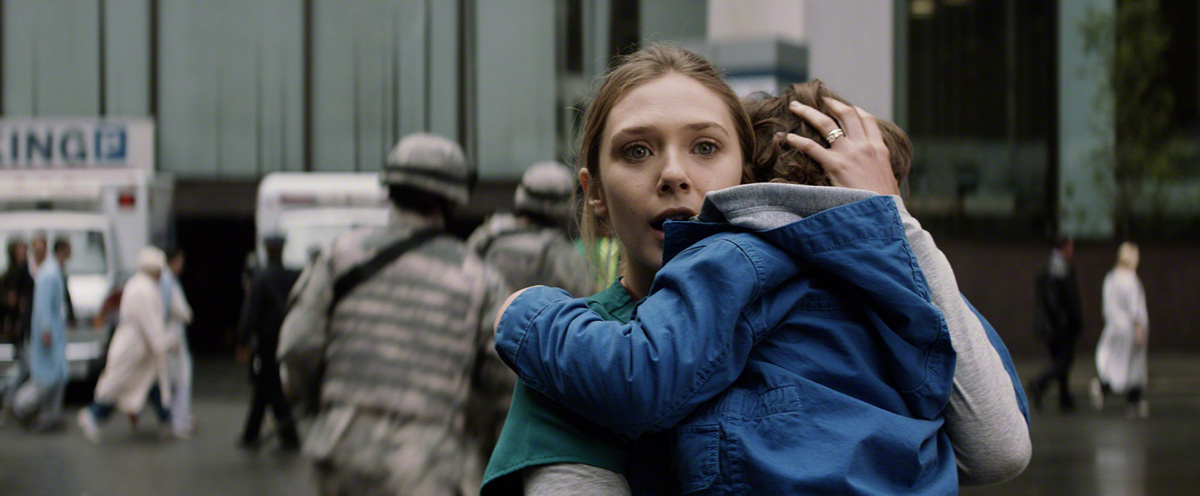Intended as a metaphor for “the bomb” and all its attendant fallout (literal and otherwise), 1954’s Godzilla achieved no small measure of financial success throughout the world, spurring countless sequels churned out by Japan’s Toho Studios
An American remake in 1998 proved memorable mainly for its drastic redesign of the iconic title character. The film generated a significant amount of flame-breath (one of the big guy’s trademarks) that, coming from the mouths of critics, was hardly welcome.
Warner Bros.’ new oversized lizard promises different results, due mostly from Gareth Edwards’ involvement. The director’s theatrical debut, the micro-budgeted Monsters, demonstrated a sure-handed visual confidence, spending just enough time on its mostly-indirect views of alien creatures to create suspense, terror and even fascination. For Godzilla, Edwards had a budget 200 times greater than Monsters, and he leveraged those dollars toward creating a definitive lizard king for our times.
“My brief to everyone was to imagine that someone in 1950s Japan had seen this huge animal for real,” Edwards shares, “and then gone to Toho, drawing an image that formed the basis for the guy in the monster suit we all love. This time, you’d be seeing the real creature for the first time and thinking, ‘So that’s why it looked this way!’”
Months were spent reviewing and upgrading a digital model, ensuring the beastie looked credible and menacing from all angles. And Edwards’ department heads – production designer Owen Paterson, VFX supervisor Jim Rygiel, and cinematographer Seamus McGarvey, ASC, BSC, all bought into his vision.
“We’re trying for a hybrid,” Edwards continues, “something between the big, spectacle–heavy CGI expectations you have with summer blockbusters and a more intimate film embedded within. Owen had worked both extremes with films as diverse as The Matrix and Priscilla, Queen of the Desert. I did the VFX for Monsters myself, mainly while watching behind-the-scenes of Lord of the Rings over and over, so Jim had become a very familiar figure before we ever met. Seamus, of course, had already done everything, and met each challenge in such an impressive way.”
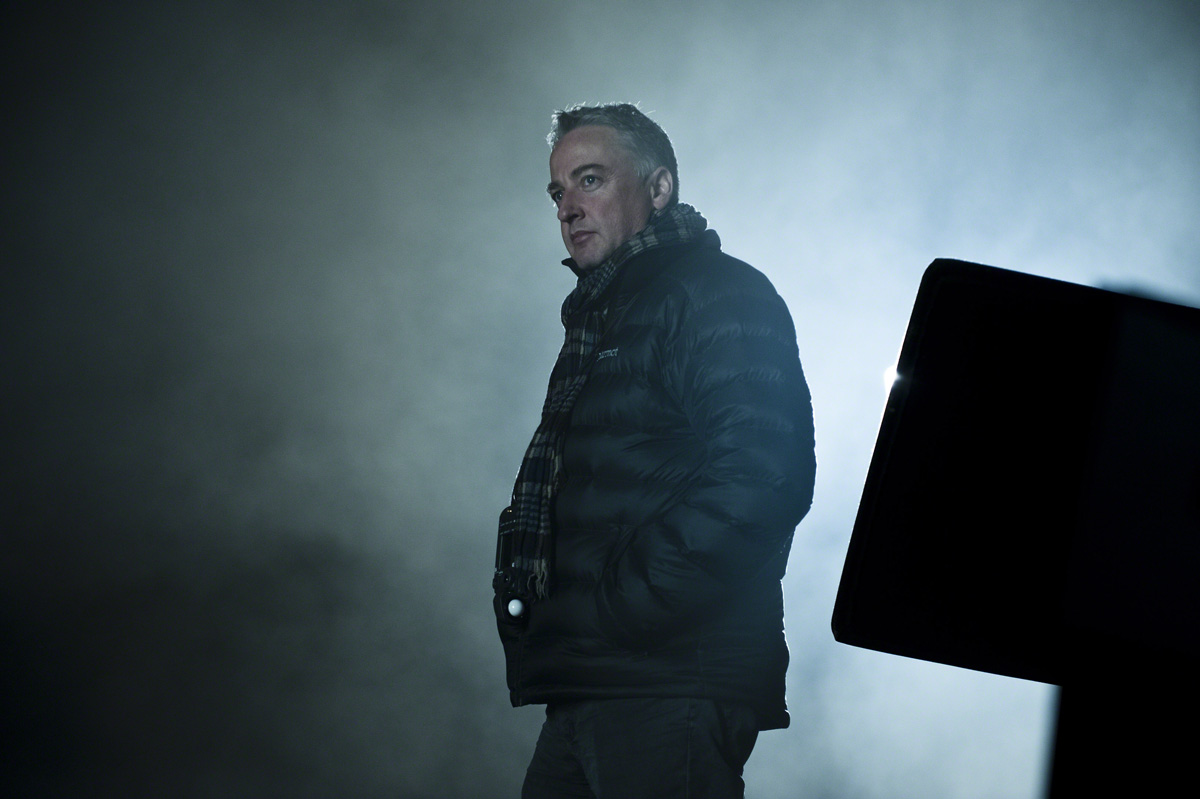
“It wasn’t just that the picture never betrayed its low-budget origins,” McGarvey says about his admiration for Monsters. “Many first-time directors trying to get into the big leagues make calling-card films that emulate bigger productions. But Gareth is a cineaste who loves telling stories in that unique way only a camera can. When I discovered Gareth had shot [Monsters] himself, it was even more evident to me that his was a talent to be reckoned with. He wanted us to maintain a very naturalistic feel, with the camera as a witness to what transpires, which is a nice contrast to the bombastic camera moves in some big films that turn into out-of-control CG rides.”
Warner Bros. and Edwards both agreed a bigger-is-better track would be pointless. “As a moviegoer, what I miss most is the structured pace and restraint demonstrated by those 70s- and 80s-era Spielberg and Coppola films that made me want to get into moviemaking,” Edwards reflects. “They were blockbusters, but they had heart and a sense of realism. Tension would build, leading to a big moment, and that buildup gave that moment real power. Whereas if you’re always dialed up to 11, there’s a diminished response, like it is all plateau. Ever since the digital revolution and the advent of CGI, we may have lost our way a bit. With my background in effects, I came to feel the honeymoon with CGI was over long ago, that it should be all about story, with effects used to achieve only that which is not affordable or can’t be captured in camera.”
“When the lights go out [in the story], we had to deal with cinematographic darkness for a long stretch, panning through 260 degrees of [location] waterfront and a half-mile-square area, but not wanting any of that sparkly backlight you get from hard sources.” { Seamus McGarvey, ASC, BSC }
Previsualization house The Third Floor helped break down what could be handled practically and which elements would be CG. Early on, they delivered a pitchvis to Warner Bros. in support of Edwards’ vision. “Pitchvis is most often used as a selling tool, like an animated movie trailer,” notes Third Floor’s creative director Chris Edwards [Exposure, page 28]. “But in this case it was so the studio could get some visual confirmation about the shape of a film they were already pretty sure they wanted to make. We worked from Gareth’s shot list, with both Warner and Legendary Pictures liking the results.” The Third Floor went on to previsualize seven sequences, including a 24-minute stretch of the film’s conclusion.
For McGarvey’s team, previs was a blessing. “It really helped my operators understand the scale of the beast,” he affirms, “as well as that of the Muto, which are other big creatures who come to town. It’s a challenge to frame for a character hundreds of feet tall when you’re shooting anamorphic. We really only see him full-length in aerial views and the odd wide shot, so it’s mostly an elliptical view. Instead of tilting all the way up to the head, we might tilt just enough to get his foot fully in frame. Previs informed us of his height and how far back he’d be. I intended to use a 40 millimeter at one point, but previs revealed the 40 would distort the creature, turning him into a pinhead. Switching to a 60 millimeter let us maintain his proper stature.”
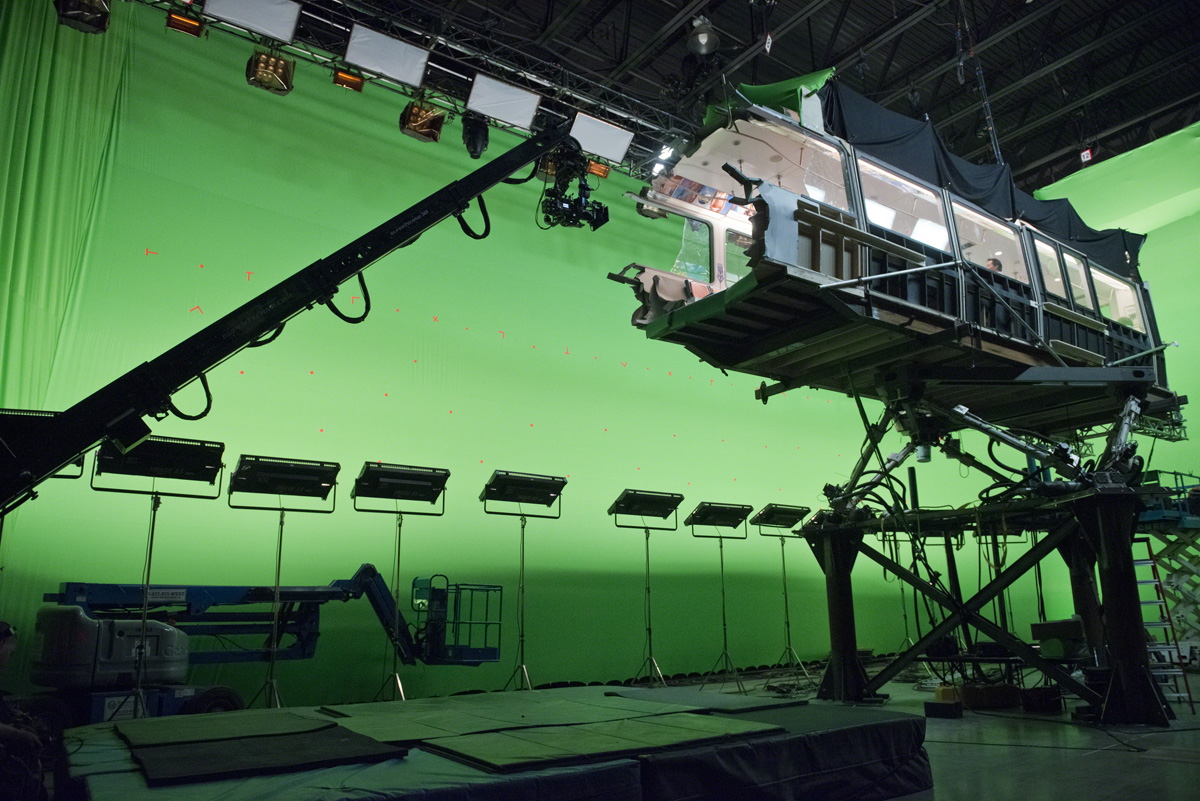 McGarvey shot Godzilla with C-series lenses on ARRI ALEXA Plus 4:3 cameras [with the Super35 sensor] supplied by Panavision, capturing to the ARRIRAW 2.8K codec. “At the moment, there is a kind of fetishism of technique that I feel a bit at odds with, even though I love some of these developments,” McGarvey admits. “Cameras are just tools allowing us to attenuate the script with a chosen emotion. Regardless of the tools, we have to continue to think about the image and the story, trusting in our taste and judgment and the experiences of our own lives to enliven the subject matter. My goal remains always to get it in camera, knowing we can ameliorate problems during the DI.”
McGarvey shot Godzilla with C-series lenses on ARRI ALEXA Plus 4:3 cameras [with the Super35 sensor] supplied by Panavision, capturing to the ARRIRAW 2.8K codec. “At the moment, there is a kind of fetishism of technique that I feel a bit at odds with, even though I love some of these developments,” McGarvey admits. “Cameras are just tools allowing us to attenuate the script with a chosen emotion. Regardless of the tools, we have to continue to think about the image and the story, trusting in our taste and judgment and the experiences of our own lives to enliven the subject matter. My goal remains always to get it in camera, knowing we can ameliorate problems during the DI.”
The DP also employed PVintage lenses for an opening sequence set decades earlier at a nuclear power station. “We looked at old pictures of Chernobyl and Robert Polidori’s images of diseased plants,” McGarvey continues, “which influenced the LUT I set for this sequence with DIT Brian Broz.” The cinematographer admits to not being a fan of fluorescents, so he elected to use many tungsten sources within overhead soft boxes to emulate fluorescents. “We needed to shift from normal lighting to a red-lit scenario, so to get a decent stop in anamorphic, we put 5Ks up there with primary red. Blondes pushed 216 atop the grid gave us a good source while letting us address all lighting changes.”
When the lighting changed to red, an ugly fact of life raised it head. “I had to convince Gareth that we couldn’t just use red light alone,” McGarvey states, “because that single color looks unfocused to the eye and the brain, which can’t process it properly. I learned that early on while filming a darkroom, where the poor focus puller got drawn over the coals because of my color choice. What I found helps is to accent through backlight with white or colored light – yellow, orange and occasionally salmon – which highlights background details in a way that lets the eye get a grip on things.”
McGarvey opts not to grade on set or immediately after a day’s shoot. “Intrusive grading can get in the way of the edit, and your mind’s not in the right place on set,” he declares. “I treat digital as I do film, applying a gray scale, and there are only certain scenarios where I have a lookup table. I may have a few looks that can act as a plug-in for the DIT, but I will not fine-tune. My look for a given scenario stays put right through to the DI.”
The aforementioned Muto have a hot time in the city, making off with a nuke to fuel their underground nest and setting off an EMP that knocks out all power. “Up till that point we shot night scenes conventionally,” says McGarvey, “with a hard backlight from sodium vapor streetlights, using Urban Vapor Green on our units. When the lights went out, we had to deal with cinematographic darkness for a long stretch, panning through 260 degrees of Vancouver waterfront [standing in for San Francisco] and a half-mile-square area, but not wanting any of that sparkly backlight you get from hard sources. Changing light color alone wouldn’t be enough of a contrast from the streetlights, and since I don’t like HMI blue for nights, we went with a very soft tungsten light.”
In order to light the expanse, gaffer Stuart Haggerty custom-built a pair of huge softlights – gelled quarter-plus green and a half blue CTB as per the DP’s preference for moonlight – using numerous Cineo TruColor HS system lights mounted into softboxes.
“Each fixture held two 24-foot-by-10-foot panels,” Haggerty reports, “one panel on each side of our 120-ton, 240-foot cranes, which could be panned and tilted via remote. We had the option of putting either a quarter- or half-grid on them, depending on how far they’d be from the action.” Weight issues precluding the use of Dino lights necessitated the special build, which output 260,000 watts. This was sufficient illumination for McGarvey, whose use of hard light in the sequence was limited to an eyelight for actors, to underexpose a stop throughout.
Bardwell & McAlister 12-lights, when put through silk with orange or half-orange, provided an appropriate soft fire light for night vistas, which were often punctuated by lightning and gunfire. “We could use flamebars on close-ups,” Haggerty states, “and looked at [Luminys 8K] Paparazzi lighting for our flash effects. But Paparazzis pointed at the lens gave a horizontal flare, so to avoid that we used Cineo TruColors, controlled through DMX. The LED light comes off a phosphorus plate and has an instant reaction without flaring.”
Since there’s little point for monsters to traipse through a metropolis without trampling a few landmarks, the Golden Gate Bridge features prominently in one sequence. Paterson built a 300-foot stretch of bridge replete with handrail, footpath, lampposts and road surface, but to facilitate VFX set extensions, a huge stretch of green screen was required. “With the storms and winds that typify the mercurial Vancouver weather,” McGarvey relates, “it would have been nearly impossible to keep the screens up for the shoot. Key grip Mike Kirilenko created inflatable 34-by-40-foot green screens that only require one set of shipping containers for support. They deflate in a few minutes and can be reinflated just as quickly. Plus you can use them as white or black backings as needed.”
Edwards’ allergy to FXy-looking visuals led him to an unorthodox approach for a huge night scene. “Even though it would mean having a roto nightmare for effects,” the director shares, “I chose to shoot it against black instead of green screen. I felt the way light bounced around that environment at night would look more realistic, and the finals look fantastic, without that distracting ‘keyed’ feel.”
Some location work inhibited the usual production setups; in one instance terrain was so inhospitable that cranes could not be brought in. “We went to an island in order to use a railway track,” Edwards continues, “and were up on a mountain near this trestle. When I got there and saw these huge lighting balloons overhead, I initially couldn’t understand why such a huge logistical effort with these light-zeppelins was necessary to get the shot. But then, when I got a look through the monitor, it revealed Seamus’ genius, because they conveyed that soft quality of real moonlight, not a ‘movie’ look.”
While a significant portion of larger environments were built in CG, Paterson’s team, including supervising art director Grant Van Der Slagt and set decorator Elizabeth Wilcox, strove to provide enough of a physical set for Gareth to maneuver actors. “We made a model in the art department establishing where in the city this street was and where the nest fit into that,” Paterson recounts. “The Third Floor scanned our model to build up a full 3D environment that served as a guide for VFX extensions. For the nest, which was supposed to be below Chinatown, we built right up to the studio perms, so Gareth could have soldiers abseiling down. This massive interior featured parts of missiles, along with a whole 18-wheeler truck buried on its side. Everything was kind of upside down, as this expanse of the city was supposed to have collapsed into this big hole. Seeing off into the distance, our set was extended with imagery obtained during a San Francisco plate shoot.”
Paterson repurposed the huge space to create a separate belowground expanse of limestone cave in which full-size skeletal remains of a “zilla” are found, enabling Edwards to stage his action with performers walking through huge neck vertebrae.
While some shooting took place aboard the USS Missouri, the bulk of naval vessel sequences were accomplished on stage, with sets ranging from the deck of an aircraft carrier to the bridge of a frigate. “For the CIC – which was a reworking of our Crow’s Nest set above the Muto base,” Haggerty reports, “we used a lot of strip bank Chimeras pointing down through grids for shadowing. We used double-full blue on these 1000-watt bulbs, and then had smaller units that dropped down on arms to give us our fill.”
Having developed an impressive workflow pipeline for Prometheus, Fluent Image handled Godzilla’s data management, ensuring colorspace issues did not arise from shuttling codecs and RAW imagery through editorial and VFX. McGarvey, whose contract always includes his involvement in the DI, worked with Technicolor’s Steve Scott. “I enjoy how subtle adjustments can be made in the DI,” McGarvey states. “Creating slight vignetting can help draw the eye to where it needs to be, and it is here that I’ll make dynamic grading calls as well.
“For me, cinematography happens when you push into a scenario, as opposed to just recording something,” he concludes. “You can shoot wildlife documentaries until the cows come home, but it’s really about the interaction between subject and cinematographer, and the impression you take to mold what is real. I love to mold gently; that’s my credo. The digital world makes looking a lazier process, so I think you have to look with a greater sense of vision, and with precision. But so long as everything is done for the film and not for effect, you’ll be all right.”
by Kevin H. Martin / photos courtesy of Warner Bros. Entertainment
Godzilla Crew
Director of Photography: Seamus McGarvey, ASC, BSC
Operator: Mitch Dubin, SOC
Assistants: William Coe
Publicist: Ernie Malik
AERIAL UNIT:
Dir. of Photography: David Nowell, ASC, Michael Kelem
2ND UNIT
Director of Photography: Roger Vernon
Assistant: Doug Lavender
LAS VEGAS UNIT
Dir. of Photography: Kim Marks
Assistant: Patrick McArdle
SAN FRANCISCO UNIT
Dir. of Photogpraphy: Kim Marks
Assistants: Patrick McArdle, , Tim Guffin
Digital Imaging Tech: Lonny Danler
Data Manager: Aaron Kirby
Still Photographers: Kimberly French, Phil Bray, Henry Nguyen



